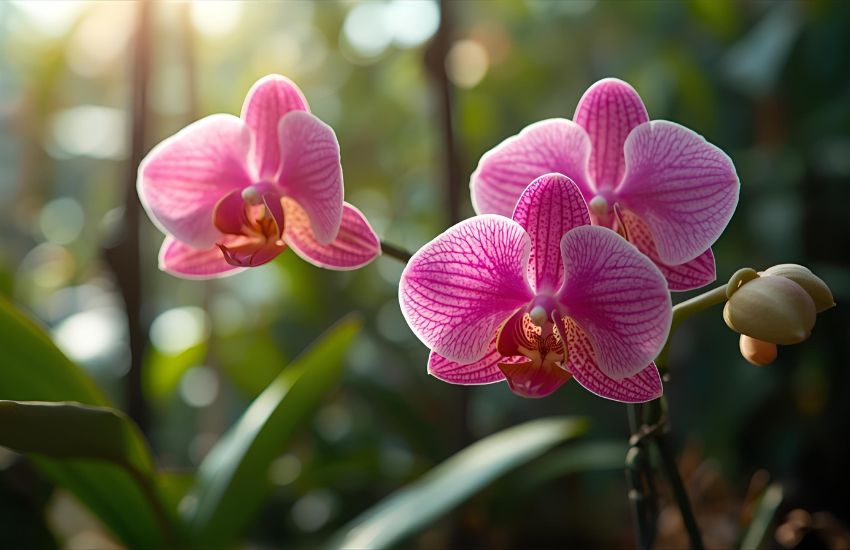Orchids captivate many indoor gardeners with their delicate beauty and diverse species, yet growing them successfully can feel challenging. If you’re seeking a clear guide to understanding orchid types and mastering orchid care, you’re in the right place. Among the most popular varieties, the moth orchid, or phalaenopsis, stands out as an ideal beginner plant due to its ease of bloom and graceful flower spikes. Yet, even the easiest orchids require attention to details like water, humidity, and proper potting to thrive indoors.
This guide helps you identify popular orchid types like moth orchids and dendrobiums, offering essential orchid care tips. Learn how to water, repot, and fertilize properly to keep your indoor orchids healthy and thriving, ensuring beautiful blooms and a vibrant indoor garden throughout the year.
This guide will help you navigate key orchid care tips, including how to water without causing root rot, when and how to repot your orchid in plastic pots or moss, and the importance of fertilizing with a dilute solution to support healthy growth. You’ll also learn about the unique needs of dendrobium orchids and how to encourage blooms from their stems. Whether you’re a beginner or an experienced indoor gardener, this blog will equip you with practical advice to nurture your orchids, keep their roots healthy, and enjoy a flourishing indoor garden year-round.
Discover the Best Orchids to Grow for Indoor Gardeners

Choosing the best orchid for your indoor garden can be both exciting and overwhelming, given the wide variety of species within the Orchidaceae family. This gardener’s guide aims to simplify your selection by highlighting orchids to grow that are not only beautiful but also manageable for indoor conditions.
Phalaenopsis Orchids: The Best Orchid for Beginners
Phalaenopsis orchids, often called moth orchids, are widely regarded as the easiest orchids to grow. Their delicate, long-lasting beautiful blooms come in colors ranging from white to purple, making them a popular choice for orchids at home. These orchids thrive in bright indirect light and prefer temperatures at night to encourage re-bloom. To avoid root rot, ensure good drainage by using a well-aerated potting mix, such as bark or sphagnum moss.
Dendrobium and Other Distinctive Species
For those seeking a new plant with upright stems and spectacular blooms, dendrobium orchids offer a distinctive addition to your indoor garden. While slightly more delicate, these orchids respond well to morning sun and balanced fertilizer. Keep in mind that dendrobiums may enter a dormant phase in autumn, requiring adjustments in plant care and watering.
Key Tips for Thriving Orchids
Regardless of the species, avoid direct sunlight or harsh direct sun, which can damage foliage and cause fragile shoots to wilt. Use tepid water for hydration and maintain a humid environment to simulate natural conditions. Repot your orchid into a new container with fresh potting mix when needed to prevent root rot and encourage healthy growth.
Whether you choose phalaenopsis orchids or explore other varieties, this comprehensive gardener’s guide will help you cultivate thriving orchids with beautiful blooms, enriching your indoor garden with elegance and charm. For convenience, nurseries and platforms like indoorplants offer a curated selection of orchids perfect for indoor gardeners.
Conclusion
Caring for orchids at home can be a deeply rewarding experience, allowing you to enjoy their delicate beauty and long-lasting blooms within your indoor garden. By choosing the best orchid varieties like phalaenopsis and dendrobium, and following essential orchid care tips such as providing bright indirect light, proper drainage, balanced fertilization, and attentive watering you create the ideal environment for thriving orchids. Remember, preventing root rot and using the right potting mix are crucial steps in maintaining healthy roots and encouraging your orchid to re-bloom season after season.
This gardener’s guide offers a comprehensive overview to support your journey in growing orchids successfully, whether you are a beginner or an experienced indoor gardener. Now that you’re equipped with practical knowledge and care tips, it’s time to bring the elegance of orchids into your indoor garden. Explore your local nursery or trusted platforms like Bloomscape to find your new plant and start cultivating beautiful blooms today.
Take the next step choose your best orchid and transform your indoor space into a vibrant sanctuary of nature’s finest Orchidaceae.
Frequently Asked Questions (The Indoor Gardener’s Guide to Orchid Types and Care Tips by Indoorplant)
What are the best orchids for indoor gardening?
Phalaenopsis (Moth Orchid): Ideal for beginners due to its ease of care and long-lasting blooms. It thrives in bright, indirect light and prefers temperatures at night to encourage re-blooming.
Dendrobium: Known for its distinctive appearance and vibrant flowers. It requires specific care, including appropriate lighting and humidity levels, to thrive indoors.
Cattleya: Renowned for its large, fragrant flowers. It prefers bright, indirect light and regular watering during its growing season.
How do I water my orchids properly?
Water your orchid when the growing medium feels dry to the touch. Ensure that the pot has proper drainage to prevent water from sitting at the bottom, which can lead to root rot.
When should I repot my orchid?
Repot your orchid every 1-2 years or when the growing medium breaks down. This helps provide fresh nutrients and space for growth.
How do I encourage my orchid to bloom again?
After the blooming period, cut the flower spike back to just above a node. Provide the orchid with cooler nighttime temperatures and reduced watering to simulate seasonal changes, encouraging it to bloom again.
